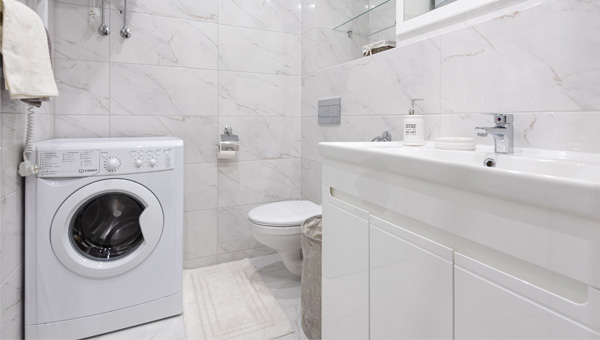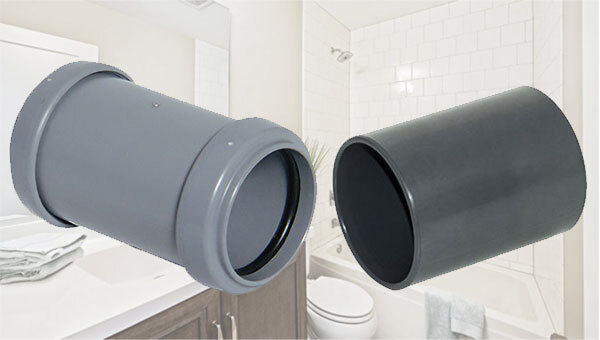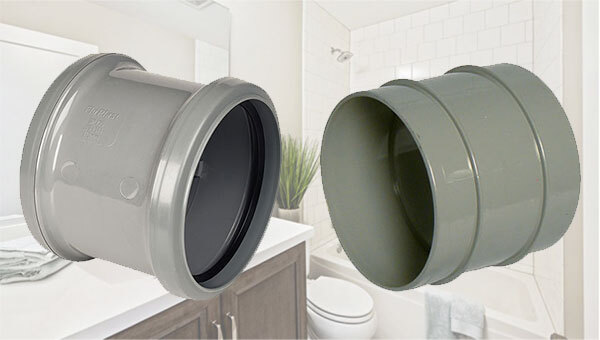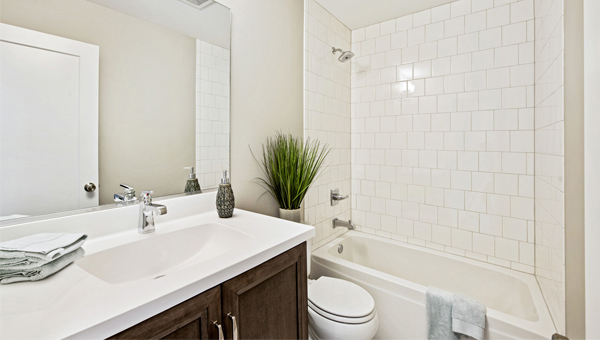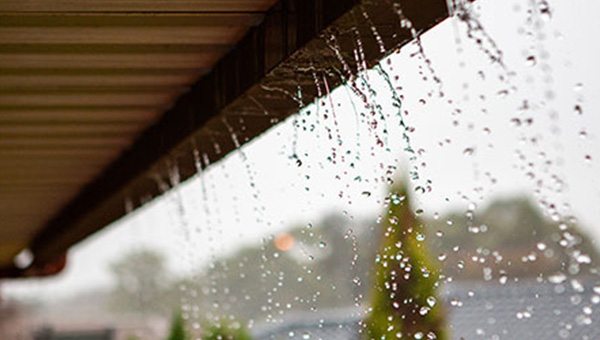
A leaking gutter can be incredibly irritating, especially if it’s right above your front door. However, while trying to dodge the drip can be a pain, the bigger concern should be about the damage that leak could be causing to your property.
Guttering systems are designed to channel water away from your walls and foundations to prevent the serious structural damage that can otherwise be caused. If you have leaks in either your gutters or downpipes, that system is failing and you need to get it fixed as quickly as possible. Fortunately, for most modern guttering systems, this is often something you can do yourself. In this article, we’ll take a look at what can cause a leak in your guttering and then guide you through the options available to repair the most common types of leaks.
What causes gutters & downpipes to leak?
Leaks in your guttering can be caused by a number of things. Most, if not all, are nothing more than you would expect, but here’s a quick look at the prime suspects anyway:
Wear and tear
Your gutters take a lot of punishment from the elements which, over time, can simply cause them to wear out. This is especially true for older systems, as the materials, designs, and manufacturing methods of guttering from 20 years ago do not live up to the higher standards of today's guttering systems. They are more prone to damage and the rubber used for the seals has a shorter lifespan than our modern range of Floplast guttering, for example. The more wear and tear these older systems take, the more likely they are to spring a leak.
Physical Damage
Gutters are quiet exposed out there on the edge of your roof and, depending on the type of material they are made from, quite often prone to physical damage from ladders being banged against them, heavy tiles or snow slipping onto them from the roof, or the weight of prolonged debris build-up. If a fitting is snapped or pulled away from the fascia, it can cause the gutters to sag which will reduce the compression on any seals present and allow water to escape through the gap. If a length of gutter is cracked due to a heavy impact, it compromises the integrity of the system and gives the water another escape route.
Expansion and Contraction
To varying degrees, depending on the material type, all gutters will expand in the heat and contract in the cold. Ever been outside your house on a warm day and heard the gutters clicking or creaking? That’s the sound of them rubbing against the brackets as they expand. Modern guttering systems are designed to withstand this process, which is why gutter fittings have insertion marks on the inside to show you how far the gutter should be pushed in. This allows for expansion and contraction without compromising the seals or having two gutter lengths pushing against each other. However, eventually the repetition of the expansion and contraction can add to the wear and tear effect on your gutters, which can lead to leaks. Joints can come apart and gutters can pop out of the support clips, which can cause the system to fail. It can also be a problem if a gutter length was cut too long or too short during installation. Without the safety buffer of space, the thermal movement caused by the changes in temperature could leave the seal exposed (if the length is too short) or reduce the pressure applied by the gutter on the seal (if the length is too long and pushes against another gutter length).
Dirt or grit in the seal
This is most often caused by the gutter contracting in cold temperatures. As the gutter “shrinks” it can draw with it bits of dirt and sediment left sitting in the joint. If even the smallest speck of this gets dragged onto the seal, it can prevent the gutter from seating properly against it and create a gap that water can escape through.
So, those are the most common causes of leaks in your guttering, most of which can be prevented to some extent by ensuring proper installation and keeping to a regular maintenance schedule (at least twice a tear) to clean out debris and check fittings stay secure after big changes in the weather. But what do you do if a leak has already been sprung? How can a gutter leak be fixed? Read on to find out.
How to fix leaking gutters & downpipes
When it comes to fixing a leak, you generally have three options to choose from, depending on where the leak is and what your guttering is made of; clean, repair, or replace. Often a leak can be the result of a blockage that’s putting pressure on a joint or seam. This can be easily fixed by cleaning the guttering and clearing out the blockage. If the leak persists however, it is likely that there is either a crack or damaged seal that needs repairing. For this task the two best options are roof and gutter sealant or weather-proofing tape. If the crack is too big or the seal is falling apart however, your best option will be to replace the damaged section.
When you have a leak in your guttering system, it will most likely be in one of three places:
Gutter joint- be it a union piece that joins two lengths of gutter, a bend, an outlet or stopend, there is always the possibility of a leak if the seal isn’t working.
Gutter length - overloaded gutters, insufficient support, and impact damage from ladders or falling branches can all cause gutters to split or crack.
Downpipe joint - most likely caused by a blockage that creates a build up of water pressure around the joint.
Let’s now take a look at how to fix each of these problems.
How to fix a leaking gutter joint
When it comes to gutter joints, the most common cause of a leak is the seal. This can be down to improper installation, wear and tear or even just a bit of grit that worked its way in between the seal and the gutter. Here are our recommendations for how to fix this.
Fixing a gutter joint leak by cleaning the seal
The first thing to do with a leaking gutter joint is to check if the leak is being caused by a bit of trapped grit or debris. Unclipping the affected union fitting and giving it a good clean could be all that's required to fix the problem.
- Drop the fitting into a bucket of warm soapy water.
- Use either your hands or a soft sponge to clean away any dirt, especially on the seals.
- Rinse off the soap suds and dry the fitting with either a cloth or some kitchen roll.
- Fit the union back in place.
- Use a bucket or hose to flush water through the gutters to test the seal.
Make sure you also clean the ends of the gutters that are joined by the union fitting as well (especially if you'd previously tried fixing the leak with silicone), to remove any built-up dirt and make sure you can achieve a good seal when reattaching the joint.
Important Note: Don't forget to ensure the ends of each gutter length are clipped into the union joint in line with the insertion/expansion mark.
If cleaning the seal doesn't fix the leak, it is probably because the seal is damaged or too worn away to do the job anymore. Depending on the fitting, you may be able to buy a replacement seal, but, more often than not, it will probably be easier just to buy a whole new fitting. If this is something you really want to avoid though, at least in the short term, you can get a quick fix for your leak with the aid of some silicone sealant.
Fixing a gutter joint leak with silicone/sealant
Often people are tempted to simply squeeze a load of silicone into any gap they find, especially around the outside of the joint, thinking that this will make it watertight again. However, general purpose silicone sealant is not ideal for this task as, while it can fill the gap, it doesn't always fully stick and may not fix your leak. That’s why you need proper roof and gutter sealant.
Roof and gutter sealants are usually butyl rubber based and work much better than silicone at creating flexible, weatherproof seals in exterior applications. Here’s how to use them:
- Unclip the gutter length that sits over the affected seal.
- Make sure the area around the seal, and the seal itself, is clean and clear of any dirt or debris.
- Use a sealant gun to squeeze out a generous line of sealant along the inside edge of the existing seal.
- Reattach the gutter up to the insertion mark in the fitting.
- This will create a new seal as the gutter squeezes down onto the sealant.
- Use a bucket or hose to flush water through the gutters to test the seal.
This is a nice and easy quick fix. However, over time it could still come unstuck through the expansion and contraction cycle of your guttering and your leak could return. Therefore, it is likely that you’ll have to replace that joint eventually.
Fixing a gutter joint leak by replacing the gutter joint
The best option to properly fix the leak is to replace the fitting altogether. A new joint with a fresh seal will instantly solve your problem. For most modern guttering systems, this is as simple job:
- Unclip the gutter either side of the union piece - push the retaining clips up and push the gutter slightly inwards to ease it out.
- Unscrew the existing union.
- Cleaning the ends of the gutters.
- Install the new union piece in place of the old one.
- Spray the seals with silicone lubricant (to improve long term performance).
- Clip the gutters back into place.
- Use a bucket or hose to flush water through the gutters to test the seal.
For older systems, especially cast-iron ones, this may be more difficult to do, as the guttering was often joined together by bolts that could have become rusted over time. These can be cut through with a hacksaw and tapped out with a hammer and nail punch, but it might be worth calling in a professional to help if you don’t feel confident in doing this yourself.
How to fix cracks or holes in your gutters
Cracks, splits and holes in your gutters can’t be fixed by any amount of cleaning, unfortunately. However, while replacement of the damaged section is again the best solution, there are some methods of repair you can try.
Fixing cracks and holes in your gutters with sealant
Depending on the size of the crack, split or hole, using a suitable roof and gutter sealant to cover the damage, both on the inside and outside of the gutter, can fix your leak.
- Clean and dry the area around the damage.
- Use a sealant gun to apply the sealant thickly over the crack or hole.
- Spread the sealant out over the surrounding area with a sealant smoothing tool (or your finger if you are wearing gloves).
- Allow sealant to set and then repeat the process on the outside of the damaged area.
- Allow sealant to set then use a bucket or hose to flush water through the gutters to test the leak is fixed.
Fixing cracks and holes in your gutters with weather-proof tape
A less messy alternative to gutter sealant is weather-proof tape. Readily available from any good trade counter or DIY store, weather-proof tape is ideal for repairing minor leaks and cracks.
- Clean and dry the area around the damage.
- Apply tape in overlapping strips to cover the crack on the inside and outside of the gutter.
- Smooth out any bubbles under the tap to ensure a good seal.
- Use a bucket or hose to flush water through the gutters to test the leak is fixed.
Replacing a damaged gutter
Though effective in the short-term both sealant and tape are really just delay tactics. The only way to properly fix a crack or hole in your gutters is to replace the damaged section. As with replacing a gutter joint, this should be a simple job for any modern guttering that uses push-fit connections.
- Unclip the gutter length from it’s support brackets- push the retaining clips up and push the gutter slightly inwards to ease it out.
- Lower the length safely to the ground.
- Clean the seals on the fittings on either side of the gap.
- Spray the seals with silicone lubricant (to improve long term performance).
- Lay new gutter length across the support brackets.
- Clip the new gutter into place using a “back to front” method on each bracket:
- Slot the back end of the gutter under the back clip of the support bracket.
- Apply gentle pressure to the front edge of the gutter until it snaps into place under the front clip of the support bracket.
- Use a bucket or hose to flush water through the gutters to test the seals are good.
If you plan to do any of the repair or replacement work yourself, check out our guide to properly planning and preparing for your gutter installation for important safety advice and other useful tips.
How to fix a leaking downpipe
The first thing you should do if you notice a leak coming from your downpipe is to give the whole guttering system a good clean and get rid of any blockages, as this will almost certainly be the cause of the leak. Follow our step-by-step gutter cleaning guide for help with this.
Clearing the blockage alone, however, is unlikely to fix your leak. As always, replacing the leaking joint or cracked length of downpipe is definitely the best option for peace of mind, and can be easily done as you clean out the blockage to save time. If you follow our cleaning guide, you will have to dismantle part of the downpipe to get at the blockage, which would then be the perfect time to remove the damaged piece and replace with a new one before connecting everything back up.
If you don’t wish to invest in a replacement part, or you manage to clear your blockage without dismantling the downpipe, you can try repairing the leak with weather-proof tape.
- Clean around the affected area to remove any dirt or lose paint (use a wire brush if you have metal guttering).
- Wrap a length of tape around the leaking joint and overlap the ends - for cracks, keep wrapping overlapping lengths of tape around the pipe until the crack is covered.
- Use your fingers to smooth out and air bubbles and mould the tape to the shape of the fitting.
- Use a bucket or hose to flush water through the gutters to test the leak is fixed.
How to find a replacement part for your guttering.
Depending on the age of your gutters, finding the exact part from the original manufacturer could be a bit tricky. Fortunately, many fittings are interchangeable (most manufacturers have comparison charts that show which competitor products their guttering will work with), and all you really need to know is the size (width of the opening at the top of the gutter), the profile (shape) and material you require - check out our guide to the different types of guttering for help identifying your gutter profile and material. For downpipes, it’s usually a lot easier as you can generally only get round or square shaped ones. It is still worth measuring the size of your gutter though, as this will normally inform the size of the downpipe you have/need. Take this information along to any good trade counter or DIY store and they should be able to find you a suitable replacement part.
And that’s it for our guide to fixing your leaky gutters. Hopefully we will have covered the problem you are having and offered a suitable solution to get it sorted. If not, check out our article listing the 10 most common gutter problems and how to fix them for more information. If you still need further advice about your rainwater guttering, do not hesitate to contact JDP today. Our expert team is always on hand to help with all of your drainage needs.


